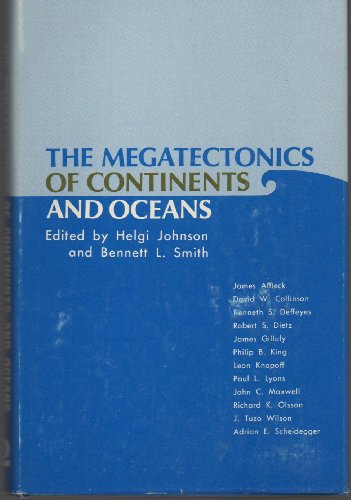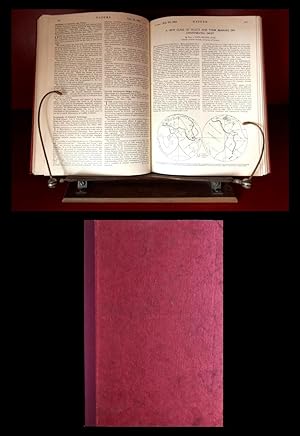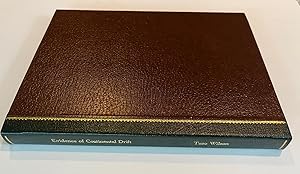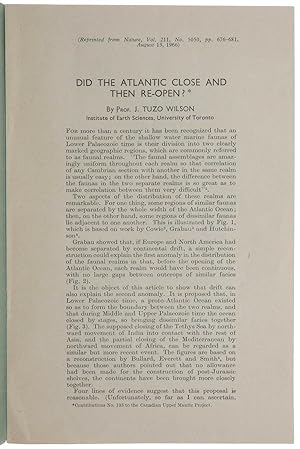Tuzo Wilson John (18 results)
FeedbackSearch filters
Product Type
- All Product Types
- Books (18)
- Magazines & Periodicals (No further results match this refinement)
- Comics (No further results match this refinement)
- Sheet Music (No further results match this refinement)
- Art, Prints & Posters (No further results match this refinement)
- Photographs (No further results match this refinement)
- Maps (No further results match this refinement)
- Manuscripts & Paper Collectibles (No further results match this refinement)
Condition
Binding
Collectible Attributes
- First Edition (7)
- Signed (No further results match this refinement)
- Dust Jacket (No further results match this refinement)
- Seller-Supplied Images (9)
- Not Print on Demand (17)
Free Shipping
Seller Rating
-
The Megatectonics of continents and oceans
Published by Rutgers University Press, 1970
ISBN 10: 0813506255 ISBN 13: 9780813506258
Seller: HPB-Red, Dallas, TX, U.S.A.
unbound. Condition: Good. Connecting readers with great books since 1972! Used textbooks may not include companion materials such as access codes, etc. May have some wear or writing/highlighting. We ship orders daily and Customer Service is our top priority!.
More buying choices from other sellers on AbeBooks
Used offers from £ 12.88
-
Unknown Binding. Condition: Good. FIRST EDITION with dust jacket - rare and collectable - will send out 1 st class post.
-
One Chinese Moon. --
Published by Hassell Street Press, 2021
ISBN 10: 1013522362 ISBN 13: 9781013522369
Seller: GreatBookPrices, Columbia, MD, U.S.A.
Condition: New.
More buying choices from other sellers on AbeBooks
New offers from £ 20.64
Used offers from £ 22.98
Also find Softcover
-
Continental drift (1960) [LeatherBound]
Publication Date: 2023
Seller: True World of Books, Delhi, India
LeatherBound. Condition: New. LeatherBound edition. Condition: New. Reprinted from 1960 edition. Leather Binding on Spine and Corners with Golden leaf printing on spine. Bound in genuine leather with Satin ribbon page markers and Spine with raised gilt bands. A perfect gift for your loved ones. NO changes have been made to the original text. This is NOT a retyped or an ocr'd reprint. Illustrations, Index, if any, are included in black and white. Each page is checked manually before printing. As this print on demand book is reprinted from a very old book, there could be some missing or flawed pages, but we always try to make the book as complete as possible. Fold-outs, if any, are not part of the book. If the original book was published in multiple volumes then this reprint is of only one volume, not the whole set. Sewing binding for longer life, where the book block is actually sewn (smythe sewn/section sewn) with thread before binding which results in a more durable type of binding. Pages: 32 Language: English.
-
One Chinese Moon
Published by Hill and Wang [1959], New York, 1959
Seller: Ground Zero Books, Ltd., Silver Spring, MD, U.S.A.
First Edition
Condition: fair. First Edition. First? Printing. 274, index, some wear and soiling to boards, sticker on rear endpaper, ink notation on front endpaper, pp. 174-5 discolored. The author, a geophysicist, narrates his journey on the Trans-Siberian Railway from Moscow to Peking, visiting China after attending a scientific meeting in Moscow.
-
I.G.Y. THE YEAR OF THE NEW MOONS
Published by ALFRED A KNOPF, USA, 1961
Seller: HISTOLIB - SPACETATI, AIX-VILLEMAUR-PALIS, France
First Edition
Couverture rigide. Condition: Assez bon. Pas de jaquette. 1ère Édition. Format:14,5/22 I.G.Y : INTERNATIONAL GEOPHYSICAL YEAR EX BOOK OF LIBRARY WITH MARKS AND STAMPS.
-
Submarine Fracture Zones, Aseismic Ridges and the International Council of Scientific Unions Line: Proposed Western Margin of the East Pacific Ridge in Nature, 207, pp. 907-911, 1965
Published by Macmillan, London, 1965
Seller: Atticus Rare Books, West Branch, IA, U.S.A.
First Edition
1st Edition. BOUND FIRST EDITION (full volume) of the last of four papers by John Tuzo Wilson providing evidence to buttress the idea of both transform faults and the Vine-Matthews hypothesis that the sea floor is spreading, here arguing "how mutually supportive these two concepts were" (Frankel, The Continental Drift Controversy, 294). Reinforcing this, Wilson's paper points "out the existence of submarine fracture zones, which transversely cut the oceanic ridges - the transform faults - showed large-scale deformation of the oceans along these narrow mobile belts that form a network between the rigid plates offsetting the ocean ridges as a result of differential movement of the plates" (Valdiya, Aspects of Tectonics, 81). [Note that we offer a number of other Wilson papers separately as well as the Vine-Matthews paper]. Wilson's contributions to the theory of plate tectonics "introduced to the mainstream the idea that continents and oceans are in continuous motion over our planet's surface" and in so doing, revolutionized the ways we understand the Earth (Heron, Plate Tectonics, The Conversation, July 4, 2016). Scientific American counts Wilson's discoveries as one of the century's five major advances in science. In this paper, "Wilson thought about the mutual consequences of transform faults and aseismic ridges, and the generally inactive ridges that extended out from mid-ocean ridges and are occasionally topped by volcanic islands. Working from the idea that aseismic ridges are formed over hot spots, he proposed. that horizontal crustal motions relative to Earth's mantle are determinable by looking at the trends of island chains with the expectation that the age of islands along each chain increases with distance from its associated spreading ridge. He also claimed that the position of ridge-offsets relative to each other should be reflected both by the magnetic pattern and by the position of aseismic ridges on adjacent blocks between fracture zones. "Using these guidelines, he argue[s] [again in this paper, p. 910], that the â??floor of the Pacific is moving northwards like that of the Atlantic Ocean and several southern continents'. Returning to the issue of whether the great fracture zones are related to the East Pacific Rise or to the Darwin Rise, he argued that the fracture zones and aseismic ridges (Emperor Seamounts, Line Islands Ridge, Hawaiian Islands, Tuamotu Islands, Society and Ustral islands, Tehuantepec Ridge, Cocos Ridge, and Nazca Ridge) are associate with the East Pacific Rise. Given the close association of all these, excepting Hawaiian Islands, with the East Pacific Rise, he claimed that their westerly extension forms the western margin of the East Pacific Rise. He named this margin the ICSU Line in honor of the International Council of Scientific Unions. He imagined the western flank of the East Pacific Rise to extend at least to the middle of the Pacific Ocean. Then [p. 908], assuming that spreading rates had been the same on either flank of the East Pacific Rise, inferred that â??its eastern margin and northern crest' must â??have been overridden by the Americas' (Frankel, The Continental Drift Controversy, 294). ALSO INCLUDED: Joseph Altman and Gopal D. Das's "Post-Natal Origin of Microneurones in the Rat Brain, pp. 953-956. "Using radioactively-tagged thymidine, Altman suggested that new neurons were added into several regions of the adult rat brain, including into the olfactory bulb (OB) and dentate gyrus (DG)" (Lois, Adult Neurogenesis, Frontiers in Neuroscience, 8, 2014, 165). CONDITION & DETAILS: London: Macmillan and Co. 4to (263 x 200mm). Volume 207, complete (the front wraps for the August 14th & September 25th issues are bound in). Ex-libris, minimal markings (slight tonal difference at the spine from spine label removal. [li], 670, [6]. Tightly and solidly bound in clean, bright red cloth, gilt-lettered at the spine. Bright and very clean throughout. Very good +.
-
Canadian North: Technical Assistant to Chief of Naval Operations for Polar Projects (OP - 03A3)
Published by Georgetown University Press, USA, 1956
First Edition
Hardcover. Condition: Fair. First Edition. Prepared for the Technical Assistant to CNO for Polar Projects. "While this work is primarily prepared for military planners, it also presents the foundation study for engineers undertaking any planned construction. It is hoped that the study leads to consideration of a transportation approach from the inland rather than depending entirely on the difficult and unreliable sea approach to certain areas requiring logistic support. Covers in detail the north Canadian mainland and Baffin Island." - from Preface. Includes several bibliographies covering the geographic areas studied. Black and white illustrations and maps. Above-average wear. Usual library markings. Binding intact. A worthy reference copy.; 4to - over 9¾" - 12" tall; Canadian North: Technical Assistant to Chief of Naval Operations for Polar Projects (OP - 03A3) Arctic Resources Maps Bibliography Canada Military Planning Cold War Defense.
-
Submarine Fracture Zones, Aseismic Ridges and the International Council of Scientific Unions Line: Proposed Western Margin of the East Pacific Ridge in Nature, 207, 5000, pp. 907-911, Aug. 28 1965
Published by Macmillan, London, 1965
Seller: Atticus Rare Books, West Branch, IA, U.S.A.
First Edition
1st Edition. FIRST EDITION IN ORIGINAL WRAPS of the last of four papers by John Tuzo Wilson providing evidence to buttress the idea of both transform faults and the Vine-Matthews hypothesis that the sea floor is spreading, here arguing "how mutually supportive these two concepts were" (Frankel, The Continental Drift Controversy, 294). Reinforcing this, Wilson's paper points "out the existence of submarine fracture zones, which transversely cut the oceanic ridges - the transform faults - showed large-scale deformation of the oceans along these narrow mobile belts that form a network between the rigid plates offsetting the ocean ridges as a result of differential movement of the plates" (Valdiya, Aspects of Tectonics, 81). [Note that we offer a number of other Wilson papers separately as well as the Vine-Matthews paper]. Wilson's contributions to the theory of plate tectonics "introduced to the mainstream the idea that continents and oceans are in continuous motion over our planet's surface" and in so doing, revolutionized the ways we understand the Earth (Heron, Plate Tectonics, The Conversation, July 4, 2016). Scientific American counts Wilson's discoveries as one of the century's five major advances in science. In this paper, "Wilson thought about the mutual consequences of transform faults and aseismic ridges, and the generally inactive ridges that extended out from mid-ocean ridges and are occasionally topped by volcanic islands. Working from the idea that aseismic ridges are formed over hot spots, he proposed. that horizontal crustal motions relative to Earth's mantle are determinable by looking at the trends of island chains with the expectation that the age of islands along each chain increases with distance from its associated spreading ridge. He also claimed that the position of ridge-offsets relative to each other should be reflected both by the magnetic pattern and by the position of aseismic ridges on adjacent blocks between fracture zones. "Using these guidelines, he argue[s] [again in this paper, p. 910], that the â??floor of the Pacific is moving northwards like that of the Atlantic Ocean and several southern continents'. Returning to the issue of whether the great fracture zones are related to the East Pacific Rise or to the Darwin Rise, he argued that the fracture zones and aseismic ridges (Emperor Seamounts, Line Islands Ridge, Hawaiian Islands, Tuamotu Islands, Society and Ustral islands, Tehuantepec Ridge, Cocos Ridge, and Nazca Ridge) are associate with the East Pacific Rise. Given the close association of all these, excepting Hawaiian Islands, with the East Pacific Rise, he claimed that their westerly extension forms the western margin of the East Pacific Rise. He named this margin the ICSU Line in honor of the International Council of Scientific Unions. He imagined the western flank of the East Pacific Rise to extend at least to the middle of the Pacific Ocean. Then [p. 908], assuming that spreading rates had been the same on either flank of the East Pacific Rise, inferred that â??its eastern margin and northern crest' must â??have been overridden by the Americas' (Frankel, The Continental Drift Controversy, 294). ALSO INCLUDED: Joseph Altman and Gopal D. Das's "Post-Natal Origin of Microneurones in the Rat Brain, pp. 953-956. "Using radioactively-tagged thymidine, Altman suggested that new neurons were added into several regions of the adult rat brain, including into the olfactory bulb (OB) and dentate gyrus (DG)" (Lois, Adult Neurogenesis, Frontiers in Neuroscience, 8, 2014, 165). CONDITION & DETAILS: London: Macmillan & Co., Ltd. Complete issue. 4to. (11 x 8 inches). Light institutional stamp on front and rear wrap; slight edge wear. Otherwise bright and very clean throughout.
-
A New Class of Faults and their Bearing on Continental Drift in Nature, Vol. 207, pp. 343-347, 1965
Published by Macmillan, London, 1965
Seller: Atticus Rare Books, West Branch, IA, U.S.A.
First Edition
1st Edition. FIRST EDITION (full volume) OF JOHN TUZO WILSON'S 1965 GROUNDBREAKING INTRODUCTION OF THE CONCEPT OF THE TRANSFORM FAULT, THE PAPER THAT FOUNDED PLATE TECTONICS" (Dewey, Marking 50 Years of the Wilson Cycle, Geoscience Canada, 43, 2016, 283). "Whereas previous theories of continental drift had conceived of plates as either moving closer together (convergent plates) or further apart (divergent), Wilson asserted that a third kind of movement existed whereby plates slide past each other. This theory became one of the bases for plate tectonics, which revolutionized the geophysical sciences" (Encyclopedia Britannica). [Note that we offer other important Wilson papers separately]. Though Wilson wrote other papers of interest in 1962 and 1963, prior to 1965, he was "a staunch anti-drifter", meaning he didn't believe in continental drift. In 1965, Wilson began to tie "together many threads to create a cohesive paradigm that embraced continental drift, sea-floor spreading, subduction, and very large motions on transcurrent faults that defined the boundaries of and sites of relative motion between plates, the basis of what would come to be known as plate tectonics" (Dewey). His earlier work, even though anti-drifter, combined with his 1965 papers, "culminat[ed] in his definitive 1965 paper [this paper] that founded plate tectonics" (ibid). Wilson's 1966 paper, "Did the Atlantic Close and then Re-open" [which we offer separately], extended the possibility of continental drift before the break-up of the once supercontinent Pangea was likewise seminal. "One might fairly say that Tuzo's 1965 paper [this paper] changed the course of global tectonics and that his 1966 paper led to a complete new understanding of the implications of his 1965 paper for the origin of mountain belts resulting from super-continent cycles, the most important paradigm change in the history of geology" (ibid, 285). His contributions to the theory of plate tectonics "introduced to the mainstream the idea that continents and oceans are in continuous motion over our planet's surface" and in so doing, revolutionized the ways we understand the Earth (Heron, Plate Tectonics, The Conversation, July 4, 2016). Scientific American counts Wilson's discoveries as one of the century's five major advances in science. ALSO INCLUDED: Nobel Prize winner Joshua Lederberg's "Signs of Life: Criterion-System of Exobiology", pp. 9-13. In 1960s, Lederberg "introduced computer science and artificial intelligence to the biomedical laboratory" (NIH). He "started working with computers and quickly became tremendously interested in creating interactive computers to help him in his exobiology research. Specifically, he was interested in designing computing systems that to help him study alien organic compounds. [He] helped devise a system called Dendritic Algorithm (Dendral) that was able to generate possible chemical structures corresponding to the mass spectrometry data as an output" (Wikipedia). ALSO INCLUDED: K. Popper's "Time's Arrow and Entropy", pp. 233-234. Popper "attacks the significance of irreversible thermodynamic processes. He claims that with very few and short-lived exceptions, the entropy in almost all known regions (of sufficient size) of our universe either remains constant or decreases, although energy is dissipated (by escaping from the system in question)" (Esfield, Popper on Irreversibility and the Arrow of Time, 4). CONDITION & DETAILS: London: Macmillan and Co. 4to (263 x 200mm). Volume 207, complete (the front wraps for the July 3rd & Aug. 7th issues are bound in). Ex-libris, minimal markings (slight tonal difference at the spine from spine label removal. [li], 670, [6]. Tightly and solidly bound in clean, bright red cloth, gilt-lettered at the spine. Bright and very clean throughout. Very good +.
-
"A New Class of Faults and their Bearing on Continental Drift" and "Did the Atlantic Close and Then re-Open?" in two issues of "Nature".
Published by Macmillan & Co., 1965
Seller: JF Ptak Science Books, Hendersonville, NC, U.S.A.
Soft cover. Condition: Very Good. (John) Tuzo Wilson, "A New Class of Faults and their Bearing on Continental Drift" and "Did the Atlantic Close and Then Re-Open?" in two issues of "Nature" (1965 and 1966). Each offered in their original paper wrappers with expertly replaced spines. There is a number in ink in the top-left corner of each issue, otherwise these very fresh and crisp issues would be near-fine. They are housed in a new, elegant, custom-made clamshell box made of calf. [++] The two papers: "A New Class of Faults and their Bearing on Continental Drift" in Nature, vol 207, no. 4995, 24 July 1965, pp 343-347 in the issue of pp 333-444 (plus ads of pp cxxxviii-clxxiv). And: "Did the Atlantic Close and Then Re-Open?"13 August 1966, pp 689-776, in the issue of pp 689-784 plus i-viii plus ix-xxxvipp ads. [++] Two important papers supporting the idea of Continental Drift. [++] These are two very significant and pioneering efforts in the history of Continental Drift. "The Canadian geophysicist John Tuzo-Wilson [CC OBE FRS FRSE FRSC (1908 1993)] was initially skeptical of the theory of Plate Tectonics, but eventually became one of its most famous supporters, proposing two important ideas. While evidence for Continental Drift was mounting, the theory still hadn't explained why active volcanoes are found many thousands of kilometres from the nearest plate boundary. In 1963, Tuzo Wilson proposed that plates might move over fixed 'hotspots' in the mantle, forming volcanic island chains like Hawaii. In 1965, he followed this discovery with the idea of a third type of plate boundary - transform faults. Also known as a conservative plate boundaries, these faults slip horizontally, connecting oceanic ridges (divergent boundaries) to ocean trenches (convergent boundaries) Transform faults were regarded as the missing piece in the puzzle of plate tectonic theory. They allowed for plates to slide past each other without any oceanic crust being created or destroyed. The most famous example is probably the San Andreas Fault between the North American and Pacific plates."-- Geological Society (website), "Pioneers of Plate Tectonics". In his career Wilson received the Wollaston Medal, Penrose Medal, and the John J. Carty Award for the Advancement of Science.
-
Did The Atlantic Close And Then Re-Open? Offprint from: Nature, Vol. 211, No. 5050, August 13, 1966
Published by Macmillan, London, 1966
First Edition
Hardcover. First edition. THE TECTONIC CYCLE. First edition, very rare offprint, of this landmark paper elucidating the history and mechanism of continental drift by "one of the most imaginative Earth scientists of his generation" (DSB). "In 1966, J. Tuzo Wilson published 'Did the Atlantic Close and then Re-Open?' in the journal Nature. The Canadian author introduced to the mainstream the idea that continents and oceans are in continuous motion over our planet's surface. Known as plate tectonics, the theory describes the large-scale motion of the outer layer of the Earth. It explains tectonic activity (things like earthquakes and the building of mountain ranges) at the edges of continental landmasses (for instance, the San Andreas Fault in California and the Andes in South America)" (Heron). Alfred Wegener (1880-1930) had already suggested in the early 1900s that continents move around the surface of the earth, specifically that there had been a super-continent (Pangaea) where now there is a great ocean (the Atlantic). In the present paper, Wilson explained the geological evidence that North America and Europe were once separated across an ocean before the Atlantic Ocean. This ocean closed in stages as the continents that used to be separated by the ocean converged by subduction and eventually collided in a mountain-building event. The combined continent was then sliced apart and the continents drawn away from each other once more as the modern Atlantic Ocean opened. The paper combined the nascent ideas of divergent and convergent plate boundaries into a conceptual model that matched observations of geological features around the world. The tectonic cycle he described now goes by 'the Wilson Cycle' or the 'Supercontinent Cycle' and still governs how we think of the evolution of tectonic plates through time. "Wilson's great idea was a crucial step forward. It reopened the whole question of 'what happened before Pangea?' By suggesting that his 'proto-Atlantic' had opened within an earlier supercontinent (just as the Atlantic did within Pangea) he also linked his process to a grander cycle leading from one supercontinent Earth to another" (Nield). As was often the case for offprints from Nature (e.g., the famous Watson/Crick DNA offprint), this offprint is printed in a smaller format than the journal issue, with the text reset. No copies in auction records or on OCLC. In the early twentieth century the prevailing wisdom regarding how mountain belts were formed and why the sea is deep was that the Earth started out as a molten ball and gradually cooled. When it cooled, heavier metals such as iron sank down and formed the core, while lighter metals such as aluminium stayed up in the crust. The cooling also caused contraction and the pressure produced by contraction caused some parts of the crust to buckle upwards, forming mountains, while other parts of the crust buckled downwards, creating ocean basins. "Originally a devotee of the contracting-Earth hypothesis, [Tuzo Wilson] became a convert to [continental] drift as he was entering his fifties (by which time he had been Professor of Geophysics at Toronto for a decade). Swiftly recanting his former views, Tuzo saw the way the Earth's mountain belts were often superimposed upon one another, and set about explaining it in terms of plate tectonics. In a classic paper published in Nature in 1966 and titled 'Did the Atlantic close and then reopen?' he addressed the coincidence of the modern Atlantic with two mountain ranges called the Caledonides in Europe and the Appalachians in the USA. It was the very first time the new plate tectonics had been extended back to the pre-Pangean Earth. "These two mountain ranges are really one and the same - except that they are now separated by the Atlantic Ocean, which cut the range in two at a low angle when it opened between them. At one time the two belts had been joined, end-to-end, Caledonides in the north, Appalachians in the south; and the collision that had created them was one event among many that built the supercontinent Pangea. Indeed, the matching of the now separated halves of this once-mighty chain provided Wegener with one of his key 'proofs' - part of his geological matching of opposing Atlantic shores . "Wegener did not speculate about how his Pangea had come together. But as the new plate tectonics emerged from studies of the ocean floor and began to revitalize drift theory, the time was ripe to see the break-up of Pangea as part of a bigger process. Professor Kevin Burke of the University of Houston, Texas, recalls that on 12 April 1968 in Philadelphia, at a meeting titled 'Gonwanaland Revisited' at the Philadelphia Academy of Sciences, Wilson told his audience how a map of the world showed you oceans opening in some places and closing in others. Burke recalls: 'He therefore suggested that, because the ocean basins make up the largest areas on the Earth's surface, it would be appropriate to interpret Earth history in terms of the life cycles of the opening and closing of the ocean basins . In effect he said: for times before the present oceans existed, we cannot do plate tectonics. Instead we must consider the life cycles of the ocean basins.' This key insight had by then already provided Wilson with the answer to an abiding puzzle in the rocks from either side of the modern Atlantic. "Nothing pleased Tuzo more than a grand, overarching framework that made sense of those awkward facts that get thrown aside because they don't fit - ideas that philosopher William James dubbed the 'unclassified residuum.' Geologists had been aware since 1889 that within the rocks forming the Caledonian and Appalachian mountains - that is, rocks dating from the early Cambrian to about the middle Ordovician (from 542 to 470 million years ago) - were fossils that fell into two clearly different groups or 'assemblages.' This was especially true for fossils of those animals that in life never travelled far, but lived fixed to, or grubbing a.





![Seller image for Continental drift (1960) [LeatherBound] for sale by True World of Books](https://pictures.abebooks.com/inventory/md/md31618549784.jpg)





